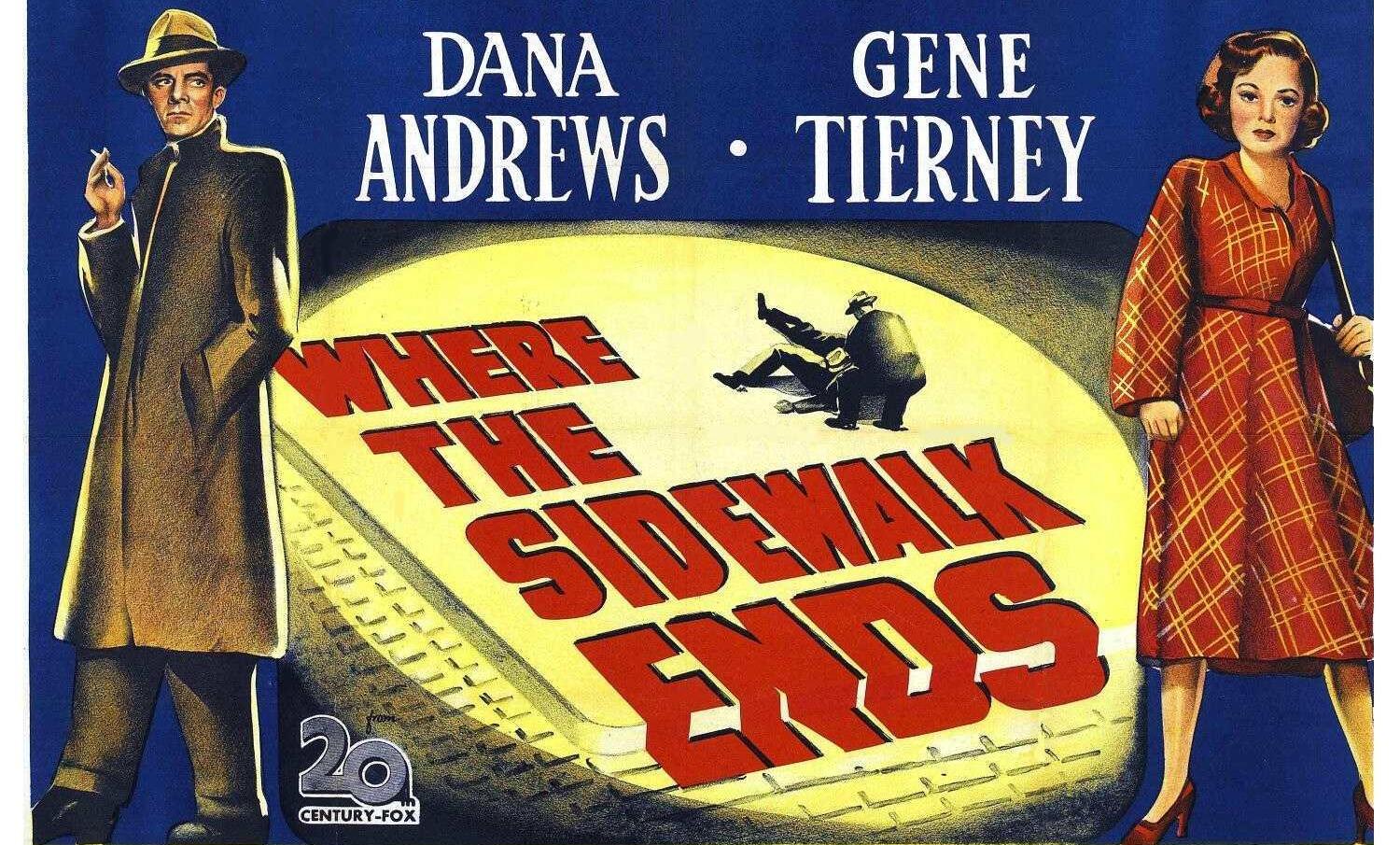
Where the Sidewalk Ends is a classic movie that has captivated audiences since its release. Directed by Otto Preminger and released in 1950, this film is a gripping film noir that will keep you on the edge of your seat. Starring Dana Andrews and Gene Tierney, Where the Sidewalk Ends takes us on a thrilling journey through the seedy underbelly of New York City.
With its intriguing plot, memorable characters, and suspenseful twists, this movie has stood the test of time and remains a must-watch for any film enthusiast. In this article, we will dive deeper into the world of Where the Sidewalk Ends and uncover 44 fascinating facts about this cinematic masterpiece. So grab your popcorn, dim the lights, and let’s explore the hidden gems behind this iconic film.
Key Takeaways:
- “Where the Sidewalk Ends” is a classic film noir from 1950, known for its gripping storyline, intense atmosphere, and stellar performances, making it a must-watch for any movie enthusiast.
- The movie explores themes of redemption, morality, and the consequences of one’s actions, while showcasing the talent of director Otto Preminger and the nuanced performances of its supporting cast.
The movie Where the Sidewalk Ends was released in 1950.
The movie Where the Sidewalk Ends is a classic film noir directed by Otto Preminger.
The film stars Dana Andrews and Gene Tierney in the lead roles.
Dana Andrews plays the role of Mark Dixon, a tough police detective with a dark past.
Gene Tierney portrays Morgan Taylor, a nightclub singer who becomes involved in a murder investigation.
Gene Tierney’s performance in the movie received critical acclaim and solidified her status as one of the top actresses of the era.
Where the Sidewalk Ends is known for its gripping storyline and intense atmosphere.
The movie combines elements of crime, suspense, and romance to create a compelling narrative.
The film features stunning cinematography, capturing the gritty streets of New York City.
The black and white visuals add to the film’s noir atmosphere and enhance the overall viewing experience.
Where the Sidewalk Ends received positive reviews from critics upon its release.
The film was praised for its strong performances, tight direction, and engaging plot.
The screenplay for the movie was written by Ben Hecht.
Ben Hecht was a renowned screenwriter known for his work on films like Scarface and The Front Page.
The movie explores themes of redemption, morality, and the consequences of one’s actions.
It delves into the complex psyche of its protagonist, questioning the line between good and evil.
Where the Sidewalk Ends features a stellar supporting cast, including Gary Merrill, Karl Malden, and Bert Freed.
These talented actors bring depth and nuance to their respective roles, adding richness to the overall ensemble.
The film’s music score was composed by Cyril J. Mockridge.
The haunting melodies and suspenseful tunes heighten the tension and add to the film’s noir ambiance.
Where the Sidewalk Ends showcases the dark underbelly of New York City in the 1950s.
It portrays a world of crime, corruption, and moral ambiguity.
The movie builds suspense through its clever plot twists and revelations.
Viewers are kept on the edge of their seats as the mystery unravels.
Where the Sidewalk Ends is often cited as one of the finest examples of Film Noir.
Its gritty visuals, compelling storytelling, and morally complex characters epitomize the genre.
The movie’s title is derived from a poem by Shel Silverstein.
This poem serves as an inspiration for the film’s exploration of the dark and hidden aspects of society.
Where the Sidewalk Ends received an Academy Award nomination for Best Sound Recording.
The film’s technical achievements were recognized for their contribution to the overall cinematic experience.
The movie’s runtime is approximately 95 minutes.
This allows for a concise and tightly paced narrative, keeping viewers engaged from start to finish.
Where the Sidewalk Ends was a commercial success upon its release.
It resonated with audiences and solidified the film’s reputation as a timeless classic.
The film was shot on location in New York City, adding authenticity to its depiction of the urban setting.
The cityscape becomes a character in itself, contributing to the overall atmosphere of the movie.
Where the Sidewalk Ends explores the psychological toll of a morally compromised protagonist.
It delves into the internal struggles of the main character as he grapples with his own demons.
The movie’s gripping climax leaves viewers questioning the nature of justice and morality.
It presents a thought-provoking conclusion that lingers long after the credits roll.
Where the Sidewalk Ends has gained a cult following over the years.
The film continues to be celebrated for its artistic merit and contribution to the film noir genre.
The dialogues in the movie are sharp and memorable, showcasing Ben Hecht’s mastery as a screenwriter.
The characters’ exchanges are filled with wit, tension, and emotional depth.
Where the Sidewalk Ends features a well-executed blend of suspenseful sequences and heartfelt moments.
It strikes a balance between thrilling action and poignant character development.
The movie’s expert use of lighting and shadows adds to its atmospheric quality.
The interplay of light and darkness mirrors the moral dilemmas faced by the characters.
Where the Sidewalk Ends explores the concept of identity and the role it plays in shaping one’s destiny.
The protagonist’s journey forces him to confront his own past and confront the person he has become.
The movie’s fast-paced narrative keeps viewers engaged throughout.
There are no dull moments as the story progresses swiftly, building towards its climax.
Where the Sidewalk Ends serves as a reminder of the timeless appeal of film noir.
Its themes and storytelling techniques continue to captivate audiences decades after its release.
The film’s remarkable performances, particularly by Dana Andrews, are a highlight of the movie.
Andrews brings depth and complexity to his portrayal of a conflicted detective.
Where the Sidewalk Ends showcases the talent of director Otto Preminger.
His masterful direction elevates the material and creates a memorable cinematic experience.
The movie’s intense and atmospheric score contributes to its overall impact.
The music enhances the mood and helps to create a sense of unease and suspense.
Where the Sidewalk Ends is a must-watch for fans of the film noir genre.
It embodies all the elements that make this genre so captivating and enduring.
The movie has been praised for its realistic depiction of police work and the criminal underworld.
It offers an intriguing glimpse into the workings of the justice system and the moral grey areas that exist.
Where the Sidewalk Ends stands as a testament to the power of storytelling and its ability to resonate with audiences across generations.
Its themes and characters continue to be relevant and thought-provoking.
The film’s screenplay expertly weaves together various narrative threads, keeping viewers engaged and guessing until the end.
There are surprises and revelations that add depth to the story and its characters.
Where the Sidewalk Ends showcases the nuanced performances of its supporting cast.
Every character brings something unique to the film, adding layers to the overall narrative.
The movie’s atmospheric cinematography creates a sense of unease and tension, immersing viewers in its world.
Every shot is carefully crafted to enhance the emotional impact of the story.
Where the Sidewalk Ends explores the consequences of one’s actions and the possibility of redemption.
It raises moral questions and challenges the viewer’s own beliefs and values.
The film’s tightly woven plot keeps viewers guessing until the final reveal.
The twists and turns of the story keep the audience engaged and invested in the outcome.
Where the Sidewalk Ends is a quintessential example of classic Hollywood filmmaking.
It combines exceptional performances, captivating storylines, and technical excellence to create an unforgettable cinematic experience.
The movie’s success paved the way for other noir films and influenced the genre for years to come.
It left a lasting impact on filmmakers and audiences alike.
Where the Sidewalk Ends has been praised for its realistic and gritty portrayal of the city.
The urban backdrop adds an extra layer of authenticity to the story.
The movie’s themes of justice, morality, and the inner struggle of its main character resonate with audiences even today.
It raises timeless questions about the human condition and the choices we make.
Where the Sidewalk Ends is a testament to the enduring power of cinema to captivate, entertain, and provoke thought.
Its legacy lives on as a landmark film in the noir genre.
The movie Where the Sidewalk Ends deserves its status as a classic and is a must-watch for any movie enthusiast.
It delivers a gripping story, memorable performances, and a thought-provoking exploration of morality.
Conclusion
In conclusion, Where the Sidewalk Ends is a captivating film that has left a lasting impact on audiences. With its engaging storyline, memorable characters, and stellar performances, it continues to be recognized as a beloved classic in the realm of cinema. The film’s exploration of morality, justice, and redemption adds depth to the narrative, making it more than just a typical crime drama. Additionally, the visually stunning cinematography and skillful direction contribute to the overall quality of the movie. Whether you’re a fan of film noir or simply enjoy well-crafted movies, Where the Sidewalk Ends is definitely worth a watch.
FAQs
1. Who directed Where the Sidewalk Ends?
Where the Sidewalk Ends was directed by Otto Preminger, a renowned filmmaker known for his contributions to the film noir genre. His masterful storytelling and unique visual style brought the film to life.
2. When was Where the Sidewalk Ends released?
The movie was released in 1950 and quickly garnered critical acclaim for its compelling narrative and exceptional performances.
3. Who are the main stars of Where the Sidewalk Ends?
The film stars Dana Andrews as Detective Mark Dixon and Gene Tierney as Morgan Taylor. Their chemistry on screen and remarkable portrayals of complex characters are a highlight of the movie.
4. Is Where the Sidewalk Ends based on a book?
No, the movie is not based on a book. It is an original screenplay written by Ben Hecht, who is known for his work on other classic films as well.
5. What is the runtime of Where the Sidewalk Ends?
The film has a runtime of approximately 95 minutes, offering audiences an immersive and thrilling experience from start to finish.
Was this page helpful?
Our commitment to delivering trustworthy and engaging content is at the heart of what we do. Each fact on our site is contributed by real users like you, bringing a wealth of diverse insights and information. To ensure the highest standards of accuracy and reliability, our dedicated editors meticulously review each submission. This process guarantees that the facts we share are not only fascinating but also credible. Trust in our commitment to quality and authenticity as you explore and learn with us.


